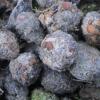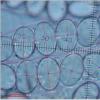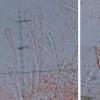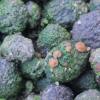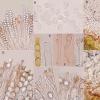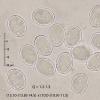
18-01-2016 18:51
 Calzada Augusto
Calzada Augusto
Hola amigos:Hace unos dias recogí en excrementos

19-01-2016 20:18
Hi to everybody Could this fungus be Diaporthe be

17-01-2016 01:28
 Rubén Martínez-Gil
Rubén Martínez-Gil
Hola a todos. Subo unas fotos de un asco que hemo

17-01-2016 11:33
Bonjour à tous, Found on Picea cone, pycnidia co

18-01-2016 10:05
Sur amandier dans le Vaucluse. C'est mon premier l

15-01-2016 23:56
 Yannick Mourgues
Yannick Mourgues
Trouvé sur tige morte de cette plantouze. Spores

14-01-2016 22:42
Para identificarMe mandan material seco desde Gali
 Hola amigos:
Hola amigos:Hace unos dias recogí en excrementos de conejo silvestre una especie de Pseudombrophila que de acuerdo con las medidas esporales y con una clave que baje de internet hace unos años y que suelo utilizar me ha llevado a Pseudombrophila leporum, aunque veo que muy prooxima a esta puede estar Pseudombrophila misturae.Me gustaria saber si alguno teneis experiencia en estos dos tipo de ascomycete y como podeis llegar a diferenciar una de la otra.Si solamente existen diferencias microscopicas en en ancho esporal o hay algun que otro caracter diferenciador.
Ahi os dejo una pequeña descripcion de la especie en cuestion:
Pseudombrophila leporum¿¿
Ascomas de forma discoidal con la superficie aplanada o ligermente cóncava. De 1 a 3(-4 mm.) mm. de diámetro. Superficie lisa. De color marrón rojizo, a marrón dátil, mas oscuro en hacia el borde del apotecio..Margen poco diferenciado. Ascas cilíndricas, de hasta 150 µm de longitud, octospóricas, con el ápice no amiloide. Ascosporas de forma anchamente elipsoidales, uniseriadas oblicuamente dentro del asca, hialinas y lisas. Paráfisis muy numerosas, ramificadas con gran numero de septos , ligeramente infladas en los ápices y en algunos tramos de los septos intemedios . Excediendo en longitud de las ascas.
Dimensiones esporales: L= (12.7) 13,4 -13,9 (14,6) µm A =(8,8) 9,3 –9,7 (10,2) µm Lm =13,7 µm A m =9,5 µm Qm= 1,4
Corología: Palencia.Carretera circunvalación Poligono industrial (Pa). 740 m. Excrementos de conejo. 23-12-2015. Leg. : A.Calzada .
Un saludo y gracias por adelantado
Hola Augusto
Yo conozco Ps. misturae pero no leporum y por lo tanto mi opinión en principio sólo vale un 50%. Yo te recomiendo que estudies cuidadosamente el excípulo de las fructificaciones para conocer los tejidos que componen las capas de éste y que parecen ser diferentes en Ps, leporum y misturae (BRUMMELEN). Por lo que has mostrado tu recolección parece tener caracteres intermedios entre ambas, con unas esporas de leporum y unas paráfisis de misturae. También te recomiendo que estudies la presencia o ausencia de uncínulos (croziers) en la base de los ascos, ausentes en Ps.misturae.
Ya me contarás.
Un abrazo

Enrique sólo dime; totalmente de acuerdo con ella.
Las dimensiones del riesgo y las esporas podrían llevar a P.leporum, pero creo que es más bien P.misturae porque paráfisis se parecen más a las de P.misturae. Tal vez usted podría medir la parte superior de la mucho más amplia que las de paráfisis P.leporum que son estrechas, filiforme.
No siempre es fácil diferenciar entre las dos especies con parientes caracteres.
Amicalement.
Michel.
Hi Michel
I said to Augusto who should study well the excipulum for to see well the differences that Brummelen wrote. Of course I think this fungus should be misturae altough the ascospores are not more broadly ellipsoid.
By the other hand, in my own experience this fungus (misturae) seems to prefer dung mixed with alcaline matters. Is this the case?
¿Los excrementos eran blanquecinos por estar mezclados con alguna sustancia alcalina?

Tengo mas ejemplares frescos y volvere a medir mas esporas y me fijare en lo que comentais, el tamaño apical de las parafisis, y la presencia de uncinulos en la base del asca,(Enrique,no me parece que las tuviera porque sino me habria llamado la atencion y las habria fotografiado).
Respecto a lo que comentas de la presencia de sustancias alcalinas, el terreno donde aparecen los excrementos es completamente de PH básico, en las cercanias de Palencia con presencia de margas yesiferas y tesos calizos , pero no me marecio que estuvieran recubiertas por una capa blanquecina alcalina.He visto tus fotos de P.misturae y me parecen macroscopicamente distintas, pero me imagino que en estas pequeñas especies dicho aspecto dice bien poco y es la micro lo que nos va a llevar a una especie u otra.Mañana las volvere a estudiar y os comento.
Un cordial saludo.
Augusto
De todas maneras como bien sabes en ocasiones unas especies parecen imbricar sus caracteres con los de otras taxonómicamente cercanas. Somos nosotros los que tratamos de meter a los seres vivos en compartimentos estancos. Tu hongo parece compartir caracteres de misturae y de leporum.
¿Tienes la monografía de Van Brummelen? Si no la tienes dímelo y te la envío.

No puedo responder a su pregunta, precisamente, me encontré con este hongo raramente (P.misturae), pero es cierto que yo no podía identificar con certeza el sustrato.
Amitiés.
Michel.

He vuelto a hacer un par de preparaciones y estas son las conclusiones:
-Las medidas esporales siguen estando en el rango esporal de P.leporum, no he encontrado ninguna que sobrepase los 10,5 µm de grosor.
-No he encontrado uncinulos ni fibulas en la base de las ascas.
-El grosor de los ensanchamientos de las parafisis suele rondar una media de 3,5 µm y en algun caso he medido hasta 5 µm.La gran mayoria de esllas son muy ramificadas y con engrosamientos a distintas alturas.En algun caso he visto excrescencias similares a las de algunas cuticulas de Myxccenas sp.
^Por mas que he intentado observar las celulas del excipulum no he podido hacer una preparacion que me aclare algo.-los ejempalres que tenia son tan pequeños que se manejan muy mal.
Asi es que con todo esto , creo que la opinion de Enrique de que podemos encontrarnos ejemplares con caracteres intermedios es la que mas se va a aproximar. El problema es que siempre queemos encuadrar una especie con algo definido en la literatura.En estos casos quizas el DNA nos ofreciera la posibilidad de acercarnos mas a una u otra.
Quizas lo mejor sera dejarla como Pseudombrophila aff.misturae.
Enrique , no tengo la monografia de V.Brumelen.He intentado encontrar las claves en pdf pero no lo he conseguido.Si me la envias te lo agradezco.
Un cordial saludo.
Augusto
En realidad hubiese sido mejor que hubieses podido fotgrafiar la terminación de la hifas ascógena y su enganche en el asco para poder certificar la ausencia de uncínulos que así sólo puede sospecharse.
Te decía lo del excípulo para ver si podias observar cuál era la anchura del excípulo ectal cortical (señalado con la letra D en la foto), que es muy delgado en Ps. leporum (sec. BRUMMELEN). Te envío en privado lo que me pides pero yo creo que tu decisión es correcta: Pseudombrophila aff. misturae.

Las ascosporas si que medi algunas fuera de las ascas, lo que pasa es que los ejemplares estaban muy lavados por las lluvias y habia muy pocas fuera de ellas, solamente alguna que otra producto del aplastamiento de las ascas.No pude ver ningun asca unida a las hifas ascogenas. Volvere a intentarlo otras vez la proxima recolecta, ya que son muchos los montones de excrementos de estos conejos silvestres los que hay en la zona de la recoleccion y en casi todos aparecian algunas fructificaciones, asi que creo que alli no sera raro volver a coger ejemplares en buen estado y a ser posible mas grandes.
De todas formas las medidas esporales de tu recolecta no se alejan mucho de las mias, quizas una micra mas gruesas de media. Asi es que lo dejaremos asi de momento.
Un cordial saludo.
Augusto

